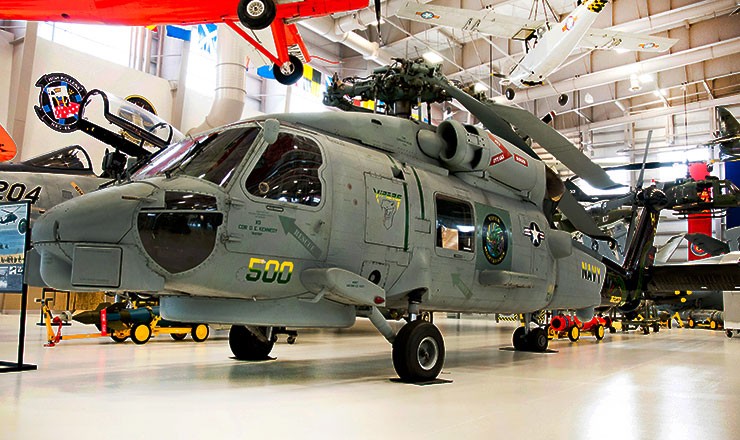SH-60B Seahawk

Low (PNG, 319x319px, 168KB)
Med (JPEG, 1280x1280px, 122KB)
The Seahawk is a modern day workhorse for the U.S. Navy. While the SH-60B like that on display specializes in anti-surface and anti-submarine warfare, a number of Seahawk variants exist, each fulfilling a unique role. Packed with an array of advanced sensors and avionics, and capable of carrying a variety of ordnance, the SH-60B has been a deadly part of the Navy's arsenal since the 1970s, and will remain so until replaced with the enhanced MH-60R.
During the 1970s, the U.S. Navy began looking for a new helicopter to replace the Kaman SH-2 Seasprite. The Seasprite was used by the Navy as its platform for the Light Airborne Multi-Purpose System (LAMPS) Mark I avionics suite for maritime warfare. Advances in sensor and avionics technology lead to the LAMPS Mk II suite, but the SH-2 was not large enough to carry the required equipment.
The Navy based its new maritime helicopter requirements on the Army's UH-60 Blackhawk to achieve commonality and lower cost. The SH-60B "Seahawk" maintained 83% commonality with the UH-60A. The main changes made included corrosion protection, more powerful T700 engines, single-stage oleo main landing gear, removal of the left-side door, two additional weapon pylons, and tail landing gear shifted 13 feet forward to reduce the footprint for shipboard landing. Other changes included larger fuel cells, an electric blade folding system, folding horizontal stabilators for storage, a 25-tube pneumatic sonobuoy launcher and an emergency flotation system in the stub wing fairings of the main landing gear.
The SH-60B airframe was manufactured by Sikorsky and integrated with mission equipment by Lockheed-Martin. The first production version SH-60B made its first flight on 11 February 1983. The SH-60B entered operational service in 1984 with first operational deployment in 1985. Since its acquisition, the U.S. Navy has expanded use of the H-60 airframe under the model designations SH-60B, SH-60F, HH-60H, MH-60S, and MH-60R. Each specific model has a unique naval mission. Able to deploy aboard any air-capable frigate, destroyer, cruiser, fast combat support ship, amphibious assault ship, or aircraft carrier, the Seahawk can perform missions in anti-submarine warfare (ASW), anti-surface warfare (ASUW), naval special warfare (NSW) insertion, search and rescue (SAR), combat search and rescue (CSAR), vertical replenishment (VERTREP), and medical evacuation (MEDEVAC). All Navy H-60s carry a rescue hoist for SAR/CSAR missions.
The SH-60B carries a complex system of sensors including a towed Magnetic Anomaly Detector (MAD) and air-launched sonobuoys. Other sensors include the APS-124 search radar, ALQ-142 ESM system and optional nose-mounted Forward Looking Infrared (FLIR) turret. It carries the Mk 46, Mk 50, or Mk 54 torpedo, Penguin missile, AGM-114 Hellfire missiles, and a single M60D/M240 7.62mm machine gun or GAU-16 .50-caliber machine gun. A standard crew for a SH-60B is one pilot, one ATO/Co-Pilot (Airborne Tactical Officer), and an enlisted aviation warfare systems operator (sensor operator). Operating squadrons are designated Helicopter Anti-Submarine Squadron, Light (HSL).
The SH-60B is now being replaced by the Navy's newest helicopter, the MH-60R. This aircraft was originally referred to as "LAMPS Mark III Block II Upgrade" when it began development in 1993. The MH-60R is designed to combine the features of the SH-60B and SH-60F. Its sensors include the ASE package, MTS-FLIR, an advanced airborne fleet data link, and a more advanced airborne active sonar. It does not carry the MAD suite. Offensive capabilities are improved by the addition of new Mk 54 air-launched torpedoes and Hellfire missiles. All Helicopter Anti-Submarine (HS) and Helicopter Anti-Submarine Light (HSL) squadrons that receive the Romeo are redesignated Helicopter Maritime Strike (HSM) squadrons.
SPECIFICATIONS
| Manufacturer: | Sikorsky Aircraft Division of United Technologies Corporation |
| Type: | ASW and anti-surface warfare |
| Crew: | Pilot, airborne tactical officer and sensor operator |
| Powerplant: | Two 1,900 shp General Electric T700-GE-401C turboshafts |
| Dimensions: | Rotor Diameter: 53 ft., 8 in. |
| Weight: | Empty: 13,648 lb. |
| Performance: | Max Speed: 145 mph at 5,000 ft. |
| Armament: | Three Mk 46 torpedoes; AGM-114 Hellfire missiles; AGM-119 Penguin missiles; rapid airborne mine clearance system; M60, M240, GAU-16/A or GAU-17/A guns |
- Aviation
- Photograph
- Image (gif, jpg, tiff)


